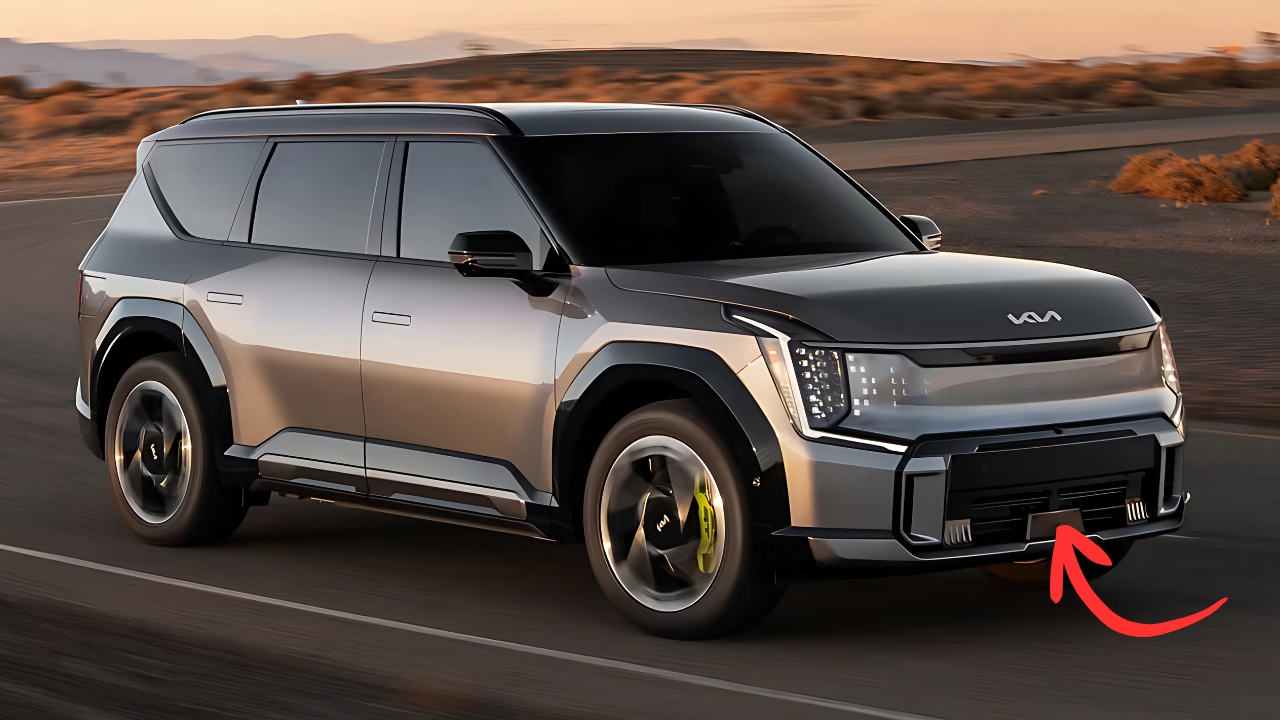Kia EV9: The electric vehicle landscape in 2025 presents a complex paradox where declining sales figures coexist with evolving manufacturer strategies. Contrary to expectations of maintaining premium pricing during market uncertainty, Kia has implemented significant price reductions for its flagship EV9 three-row electric SUV, with some trims seeing cuts of up to $2,000 for the 2026 model year.
This strategic pivot comes at a time when Kia sold just 37 EV9 units in May 2025, representing a dramatic 98.3% decline from the 2,187 units sold in May 2024. The stark sales figures underscore the broader challenges facing the electric vehicle industry, where automakers are grappling with slower-than-expected battery electric vehicle demand and increasing regulatory pressures.
The Broader Electric Vehicle Market Slowdown
Industry-Wide Challenges Create Perfect Storm
The electric vehicle sector is experiencing what industry analysts describe as a significant deceleration in growth momentum. In April 2025, new EV sales declined by 5.9% month-over-month to 100,495 units, while also dropping 5.6% year-over-year. This downturn reflects several converging factors that have reshaped consumer behavior and manufacturer strategies.
Major automakers have responded to market conditions by slashing over 50,000 jobs, cutting production, and delaying EV plans as consumer demand falls short of expectations. The situation has become so pronounced that suppliers are reducing workforce in response to slowing EV sales growth, creating ripple effects throughout the automotive supply chain.
Consumer Preference Shifts
Market research indicates that consumer preferences have evolved significantly, with sales of hybrid electric vehicles (HEVs) and plug-in hybrid electric vehicles (PHEVs) accelerating amid the slowdown in pure electric vehicles. This shift suggests that consumers remain interested in electrification but prefer technologies that address range anxiety and charging infrastructure concerns.
The payback period for HEVs is estimated at just over three years, assuming annual fuel savings, compared to longer payback periods for pure electric vehicles. This economic reality, combined with established confidence in hybrid technology reliability, has influenced purchasing decisions across multiple market segments.
Kia’s Strategic Response: The EV9 Pricing Revolution
Price Cuts Across Multiple Trims
Despite facing challenging market conditions, Kia has chosen an aggressive pricing strategy for the 2026 EV9. The EV9 Light Long Range drops from $59,900 to $57,900, while the EV9 Land falls from $69,900 to $68,900, and the EV9 GT-Line sees its price reduced from $73,900 to $71,900. These reductions represent substantial savings for consumers while positioning the EV9 as a more competitive option in the three-row electric SUV segment.
The base model pricing strategy remains particularly noteworthy, as Kia held the line on pricing with the base EV9 continuing to start at $54,900 before a $1,495 destination fee. This approach maintains accessibility at the entry level while providing increased value in higher trim levels.
Enhanced Features and Range Improvements
Accompanying the price reductions, Kia has implemented meaningful improvements across the EV9 lineup. The GT-Line achieves 280 miles per charge, a 10-mile increase from its previous 270 miles, while the Land and Wind trims now deliver 283 miles per charge, representing three-mile gains. Most significantly, the Light LR trim boasts the most substantial improvement, jumping to 305 miles—an increase of one mile over its prior rating.
These enhancements stem from battery optimizations and engineering refinements that demonstrate Kia’s commitment to continuous improvement despite market headwinds. The company has also introduced a new Nightfall Edition package based on the upscale Land trim, featuring gloss black accents and exclusive Roadrider Brown paint.
Supply Chain Dynamics and Market Timing
Inventory Transitions Create Sales Gaps
The dramatic sales decline in May 2025 reflects more than just reduced consumer demand. The 2025 Kia EV9 sold out sooner than expected, and although 2026 models are starting to arrive at dealerships, they are still pretty hard to come by. This inventory transition period has created temporary supply constraints that have affected monthly sales figures.
AutoTrader shows 1,215 new Kia EV9 models at dealers, but virtually every one represents a model-year 2026 vehicle with renderings instead of actual photos, confirming that the 2026 model year EV9s are not yet available in stores. This situation demonstrates the complexities of managing product transitions in a rapidly evolving market.
Dealer Incentives and Consumer Benefits
Prior to the transition, Kia was offering significant discounts on 2025 EV9 models, including a $10,000 customer cash rebate or 0% APR financing. These aggressive incentives helped clear remaining 2025 inventory while providing substantial value to consumers willing to purchase the outgoing model year.
Competitive Landscape and Market Positioning
Three-Row Electric SUV Segment Dynamics
The EV9 operates in a relatively exclusive market segment, as very few electric SUVs offer three rows of seats, and even fewer come from mainstream brands. This positioning provides Kia with both opportunities and challenges, as the limited competition allows for premium positioning while also restricting the overall market size.
The EV9’s starting price undercuts luxury alternatives like the Mercedes-Benz EQS SUV, Rivian R1S, Tesla Model X, and Volvo EX90 by tens of thousands of dollars, making it an attractive option for families seeking electric vehicle technology without luxury car pricing.
Value Proposition in Challenging Times
With its updated range, lower prices, and spacious design, the 2026 EV9 is positioned to remain a top choice for families transitioning to electric driving. The combination of price reductions and feature improvements creates a compelling value proposition that addresses consumer concerns about electric vehicle pricing and capability.
Future Market Outlook and Industry Implications
Long-Term Strategic Considerations
Despite the current slowdown in EVs, base-case scenarios still call for EV sales volume to rise 21% year-over-year in 2024, suggesting that current challenges represent a temporary adjustment rather than a fundamental shift away from electrification. This perspective supports Kia’s decision to maintain competitive pricing and continue product development.
The success of Kia’s compact electric SUV models in other markets, with the EV3 leading growth with 17,878 units sold in Q1 Europe, demonstrates that the company’s broader electrification strategy remains viable despite challenges in specific market segments.
Industry-Wide Transformation
As the automotive sector continues to evolve, stakeholders must engage in proactive dialogue to ensure that the transition is managed effectively, preserving both jobs and the competitive viability of the industry. Kia’s pricing strategy represents one approach to navigating this complex transition period.
The current market conditions require manufacturers to balance multiple competing priorities: maintaining profitability, supporting ongoing research and development, meeting regulatory requirements, and responding to evolving consumer preferences. Kia’s approach with the EV9 demonstrates how automakers can adapt their strategies to remain competitive during uncertain market conditions.
2026 Kia EV9 Pricing and Specifications
| Trim Level | 2025 Price | 2026 Price | Price Change | Range (miles) |
|---|---|---|---|---|
| Light Standard Range | $56,395 | $56,395 | No change | 230 |
| Light Long Range | $61,395 | $59,395 | -$2,000 | 305 |
| Wind AWD | $65,395 | $65,395 | No change | 305 |
| Land AWD | $71,395 | $70,395 | -$1,000 | 283 |
| GT-Line AWD | $73,395 | $71,395 | -$2,000 | 280 |
Prices include $1,495 destination fee
Frequently Asked Questions
Q: Why did Kia reduce EV9 prices despite the market slowdown? A: Kia implemented strategic price cuts to maintain competitiveness and attract price-conscious consumers during a challenging market period while also improving vehicle range and features.
Q: Are the 2026 EV9 models available now? A: The 2026 EV9 models are beginning to arrive at dealerships, but availability remains limited as Kia transitions from the sold-out 2025 model year.
Q: How does the EV9 compare to other three-row electric SUVs? A: The EV9 significantly undercuts luxury competitors like the Rivian R1S and Mercedes EQS SUV by tens of thousands of dollars while offering similar three-row functionality.
Q: What improvements does the 2026 EV9 offer? A: The 2026 model features improved range across most trims, new Terrain Mode for AWD models, and enhanced battery efficiency, along with reduced pricing on several trim levels.

